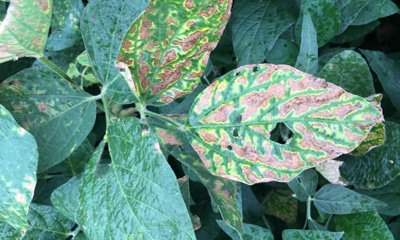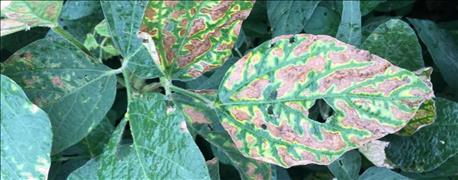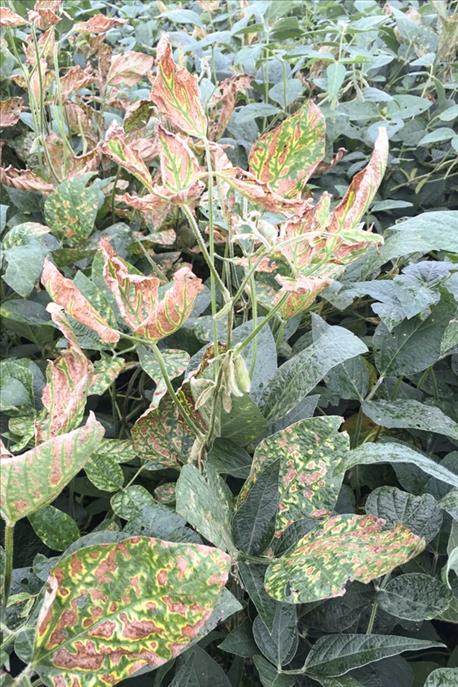September 1, 2016

As of late August, there have been several reports of sudden death syndrome showing up in soybeans. This is the time of year to identify stem and root rots like SDS to make plans for future years.

FIGURE 1: Foliar symptoms of SDS start as chlorotic blotches between the veins (leaves in the background) and advance to necrotic areas with bright-yellow margins. Veins remain green.
Wet soil conditions earlier this year were favorable for early SDS infection. Heavy rains during flowering are also favorable for development. The first signs of SDS appear as scattered yellow or white spots on the leaves in the upper canopy. In the intermediate stage, these spots eventually coalesce to form brown streaks between the veins (interveinal necrosis) (Figure 1). On these leaves only the midvein and major lateral veins remain green (Figure 2). As the disease reaches the more advanced stages, premature defoliation occurs with petioles (leaf stems) remaining on the plant.
Disease progression
The progression from early symptom to defoliation will occur rapidly (less than 14 days in most cases). Symptoms of SDS can be confused with those of brown stem rot. To differentiate the two, split the stems of infected plants and check for discoloration. If the pith (center stem) is discolored, this is a symptom of brown stem rot. With SDS, stem discoloration will be confined to the outer stem layers (vascular tissue) and can extend up the stem of infected plants. In addition to aboveground symptoms, plants with SDS typically will have a rotted taproot and plants will pull easily. Upper lateral roots often are not affected.

FIGURE 2: As SDS continues to develop, the leaves turn brown, while the veins remain green. Eventually the leaves drop, leaving the petiole (leaf stem) attached.
The best action at this time is to identify these and other problems correctly so that you can develop a management strategy the next time soybeans are grown in the field. No action can be taken at this time to reduce the effect of SDS. As with any disease, to properly manage it, the correct diagnosis is critical.
Diagnosis and resources
If uncertain of the cause of damage in a field, have the plant damage identified at the University of Nebraska Plant and Pest Diagnostic Clinic.
More information on these and other soybean diseases can be found in the Soybean Disease Management section of CropWatch and on SoyCal.
Giesler is a University of Nebraska Extension plant pathologist.
You May Also Like




